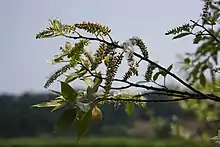| Salix kusanoi | |
|---|---|
 | |
| Scientific classification | |
| Kingdom: | Plantae |
| Clade: | Tracheophytes |
| Clade: | Angiosperms |
| Clade: | Eudicots |
| Clade: | Rosids |
| Order: | Malpighiales |
| Family: | Salicaceae |
| Genus: | Salix |
| Species: | S. kusanoi |
| Binomial name | |
| Salix kusanoi | |
Salix kusanoi is a species of willow in the family Salicaceae. It is endemic to Taiwan. It is threatened by habitat loss.[1]
It is a deciduous tree growing to 7 m (23 ft) tall. The leaves are alternate, 9 cm long and 4 cm broad, with finely serrated edge and glands. Both sides of the leaves are green and have dark orange fine hairs. The hairs on the underside of the leaves are more obvious, and the hairs can be easily wiped off. The flowers are produced in early spring before the new leaves appear. It is dioecious, with male and female catkins on separate plants. The male catkins are 8–9 cm long; the female catkins are 3 cm long.[2]
 Male catkins with golden yellow flowers
Male catkins with golden yellow flowers Leaf. Leaf bases are often heart-shaped.
Leaf. Leaf bases are often heart-shaped. The fine hairs on the leaves
The fine hairs on the leaves Young leaves
Young leaves Branches and leaves
Branches and leaves Bark of a young plant
Bark of a young plant Young plant with male flowers
Young plant with male flowers
References
- 1 2 Lu, S.Y.; Pan, F.J. (1998). "Salix kusanoi". IUCN Red List of Threatened Species. 1998: e.T31250A9619786. doi:10.2305/IUCN.UK.1998.RLTS.T31250A9619786.en. Retrieved 17 November 2021.
- ↑ Flora of China: Salix kusanoi
 Media related to Salix kusanoi at Wikimedia Commons
Media related to Salix kusanoi at Wikimedia Commons Data related to Salix kusanoi at Wikispecies
Data related to Salix kusanoi at Wikispecies
This article is issued from Wikipedia. The text is licensed under Creative Commons - Attribution - Sharealike. Additional terms may apply for the media files.
